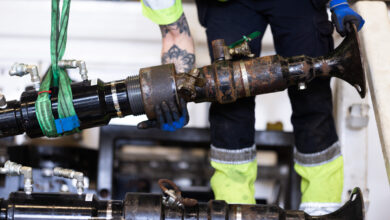BP’s Looney: To remain competitive, costs must be lowered sustainably, not follow oil prices

By Kelli Ainsworth, Editorial Coordinator
World energy demand is likely to increase by a third by 2035, according to BP’s forecasts. However, oil and gas will face increasing competition from alternative energy sources over the coming years, BP Chief Executive of Upstream Bernard Looney said at the 2016 OTC on 2 May in Houston. “The competitiveness of alternatives is improving,” he said. “They may only represent a small part of the energy mix today, but we cannot afford to ignore them.” In order to retain its stake in the world energy mix, the oil and gas industry must work to drive continuous improvement and boost productivity while lowering its costs.
One of the reasons for this increased competitiveness is that alternatives are becoming more and more affordable. The cost of onshore wind electricity has been cut in half since 2009, while the cost of solar manufacturing has been reduced by three-quarters in the same time period, Mr Looney said. At the same time, the cost of batteries for electric vehicles is projected to fall by 77% between 2010 and 2018. “In most industries, such as manufacturing or aviation, costs go down with time,” Mr Looney said. “In the oil and gas industry, specifically upstream, costs tend to follow the oil price. We need to change this.”
The US unconventional revolution could provide a model of how to improve productivity. Mr Looney noted that though the onshore rig count has experienced a nearly 80% reduction, production hasn’t fallen much. At the same time, Mr Looney noted that BP has seen development costs fall by 60% in its wells in the San Juan basin in New Mexico and Colorado. “This combination of innovation and continuous improvement is the driving force for the future,” he said. “It’s how we will improve the productivity of our oil sector and cut costs on a downward curve.”
Continuous improvement must also be applied to safety, he noted. In addition to reinforcing a culture of personal responsibility for safety “from the oil platform to the boardroom,” BP has invested in technology such as advanced satellites that can provide greater information about safety risks. These technologies enable BP to manage risks without having to stop work, which in turn improves productivity. Since 2010, BP has seen a 70% drop in its total number of tier 1 process safety events, Mr Looney said.
Embracing digital technology and big data will enable further improvement to productivity and operations. Later this year, BP will deploy a new technology called Plant Operations Advisor, developed with GE, in the Gulf of Mexico (GOM). It acts as an early warning system and alerts engineers about anomalies and corrects them before they turn into problems. “It brings huge volumes of real-time data and applies predictive analytics to it,” Mr Looney said. The company has already been utilizing a remote digital monitoring system called Well Advisor that monitors BOPs, casing running and other equipment in real time. So far, Mr Looney said, this technology has been used in more than 600 casing runs and has saved BP an estimated $200 million in CAPEX and reduced nonproductive time.
Collaboration can also yield significant cost reductions. “It’s about being open to new ideas and suggestions from partners and suppliers,” Mr Looney said. Through intensive collaboration with its partners and suppliers in the GOM, BP was able to lower the expected cost of its Mad Dog Phase 2 project from $20 billion to $10 billion. Training all personnel who will be working together on a rig together, rather than in silos, can lead to improved performance and efficiency. In 2015, BP trained its own employees alongside contractor employees in Egypt at one of Maersk Training’s drilling simulators. This combined training has helped BP rig teams in Egypt complete six of the company’s best-ever wells in the Nile Delta basin, Mr Looney said.
These and other efforts at improving performance and reducing costs have to be ongoing, Mr Looney said, rather than a temporary measure during a period of low oil prices. “We need to be able to compete on a global scale with other energy and transport sectors,” he said. “It will require innovation and continuous improvement, getting a little better in everything that we do every single day. Most importantly, we have to hold on to this even when the oil price recovers because that’s when the true test will come. If we do that, then I strongly believe in a long and successful future for the industry.”




